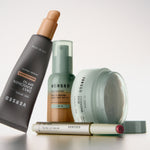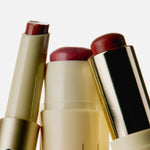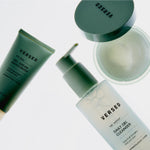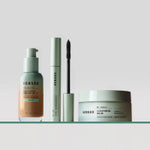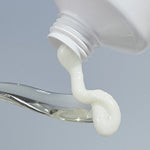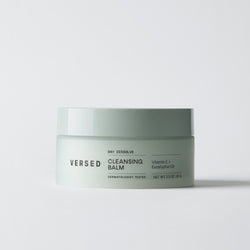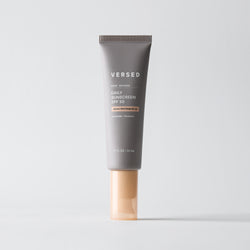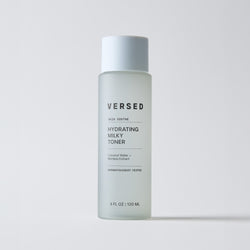When should you start using products for aging skin? Science says there’s no time like the present. Studies show that only 10% of skin aging is actually caused by your age. The other 90% of wrinkles, loss of firmness, uneven texture, and more are likely to appear due to extrinsic factors outside of genetics and simply growing older—something experts refer to as premature aging.
It’s unrealistic to shield skin from everything and anything that can contribute to premature aging—unless we choose to hibernate in an airtight, filtered, windowless box—but there are some manageable ways to protect and support your complexion and limit potential damage. We dive into all the reasons skin may be aging prematurely—and what products can help—below.
AGING SKIN VS. PREMATURE AGING SKIN
Concerns like crow’s feet, sagging skin, and age spots have historically been lumped into one robust category: Aging skin or “mature” skin. This has led many to assume that these changes only occur as we grow older, and there’s not much to do about it. But, scientifically, aging skin is divided into two distinct categories: Intrinsic aging and extrinsic (or premature) aging.
Intrinsic aging includes any changes that occur due to our DNA and genetic makeup as our internal systems begin to shift and degrade; what signs of aging show up (and when) are unique to you. Signs of extrinsic aging, on the other hand, are changes that occur at any age due to outside factors; this can include any environment (like polluted cities), habit, or situation that causes skin damage. Both types of aging skin may look the same, but only premature aging is preventable—to a certain extent, of course.
WHAT CAUSES PREMATURE AGING SKIN?
Whether you’re starting to notice early signs of aging or simply want to prevent, prevent, prevent, keep an eye on the below to help protect your skin from premature damage.
THE SUN AND UV RAYS
The possibility of a sunburn alone should be enough to clue us in to how harmful UV light is. Not only can the sun cause cancer, but its rays damage skin’s elastin and collagen fibers—causing fine lines, sagging skin, and a crepey texture—and leave behind hyperpigmentation (a.k.a. age spots). It’s not just sunlight we have to think about, however. There’s evidence that HEV light, the blue light that is emitted from our phones, laptops, and other screens, may cause premature aging skin as well. This is why wearing sunscreen daily is so vital to keeping skin bright, smooth, and firm. Just make sure you’re reapplying every two hours and wearing one that’s broad-spectrum (like Guards Up). Adding a visor and staying in the shade always helps, too.
POLLUTION
Environmental pollutants, particularly ones found in our air and water supply, impact our lungs, immune system, and, yes, our skin health. Forms of pollution like sulfur dioxide, particulate matter, and cigarette smoke produce free radicals and create oxidative stress that breaks down collagen, leaving behind lasting damage such as fine lines and loss of firmness.
Conserving gas and recycling are just some simple actions you can take to help protect the Earth, but as for your skin, load up your routine with antioxidants, such as vitamin C, E, and A (a.k.a. retinol). Antioxidants neutralize free radicals and stop oxidation before it occurs. Our Antioxidant Oil-Serum is chock full of them; plus, it delivers a glowing, softened complexion.
ALCOHOL, TOBACCO, AND SUGAR
Speaking of pollution, add premature aging to the growing list of reasons not to smoke cigarettes. Tobacco is made up of over 7,000 chemicals that damage the body—including the skin. Studies show that smokers produce enzymes that destroy collagen, leading to a variety of skin concerns. And while there’s no harm to sipping a glass of wine once in a while, know that drinking alcohol can also accelerate aging skin. Skin becomes more dry as it ages, and alcohol’s dehydrating qualities can exacerbate flaky, rough texture and make fine lines more apparent. To help combat these, moisturize with the vitamin-E filled Rich Moisture Cream.
PS: Watch your sweets too—research suggests a sugar-heavy diet gives off damaging free radicals.
SLEEP
There’s a reason why tired complexions look so, well, tired. Bedtime is when the skin goes into deep repair mode, speeding up its cellular turnover rate and increasing collagen production. A lack of sleep, on the other hand, reduces the skin’s defense system and increases inflammation—both of which lead to damage. Other bedtime habits, such as investing in silk linens and sleeping on your back, may also reduce the appearance of wrinkles that stem from friction against your sheets and pillow.Don’t forget to hydrate against water loss with a night cream and eye balm. Recovery Mode smooths rough, crepey textures while Smooth Landing—made with line-smoothing, firming granactive retinoid and moisturizing oils—can prevent and repair appearance of crow’s feet.
